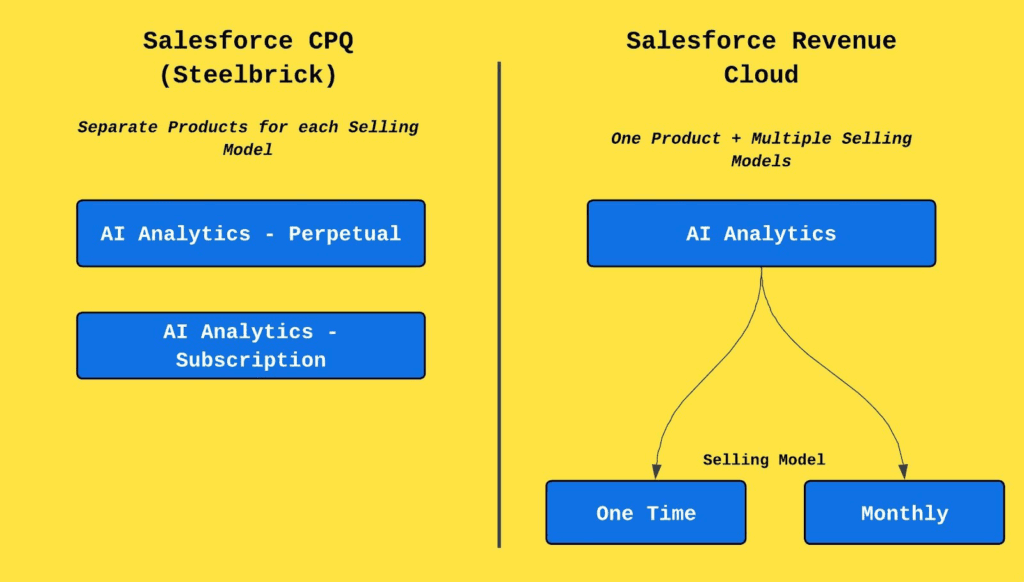
Selling Model in Salesforce Revenue Cloud: One Product, Multiple Ways to Sell
This post describes why the selling model in Salesforce Revenue Cloud is a game changer for organizations by helping simplify product catalogs..
If you’ve worked with traditional CPQ tools for any length of time, you know that today’s businesses need agility, with products that are sellable in multiple ways: One-time fee? Monthly subscription? Annual subscription? If you think about Salesforce CPQ (Steelbrick) for example, each of those options usually means a separate product. Multiply that across a growing portfolio, and suddenly you’re drowning in product records that are nearly identical, with just one difference: How you sell them.
In reality, product catalogs are no longer static repositories of SKUs, and Salesforce Revenue Cloud embraces that by introducing the Selling Model concept: This empowers businesses to streamline catalogs, support flexible monetization, and align with modern go-to-market strategies. Certainly, a strategic evolution from the traditional Salesforce CPQ (Steelbrick) model.
Salesforce CPQ Product Structure: A Rigid Framework
In Salesforce CPQ, every variation in how a product is sold had to be modeled as a separate product. For example, say you sell a software tool called “AI Analytics” If you offer it both as a one-time license and a monthly subscription, you’d need two separate product entries:
- AI Analytics – Perpetual
- AI Analytics – Subscription
That’s not only redundant, it’s inefficient. You’re managing two records with duplicate descriptions, configurations, and pricing logic just to change the billing type. Now scale that across 50 products with 3 pricing models each… You get the picture. At the end of the day, this results in cluttered catalogs, maintenance overhead, and more importantly, lack of abstraction for selling logic. In this model, the monetization strategy is tightly coupled with the product definition, making it difficult to adapt as business models evolve.

The Selling Model in Salesforce Revenue Cloud is a Game-Changer for Current Product Catalogs
Revenue Cloud flips the model. Instead of duplicating products for each selling style, you define one product and attach multiple selling models to it. The Selling Model concept, in hindsight, decouples the product from its selling strategy, allowing multiple monetization models to be applied to a single product. This approach reflects how companies actually structure their offerings in today’s market.
Following the example above, here’s how that works:
- The product stays the same (“AI Analytics”).
- You create separate Selling Models for different selling styles:
- One-time fee
- Monthly subscription
…and when it’s time to quote, the sales rep just picks the right model. No more hunting for the “right” product version.
Introducing the Selling Model dimension not only eliminates the need for duplicated products, dramatically reducing catalog sprawl and simplifying product lifecycle management, but also adds greater flexibility in quoting: Sellers can select the appropriate selling model at the time of configuration or quote creation, depending on the customer’s needs. The Product is the same, the way you sell it is different.
Think about the Selling Model as a child of a Product (one to many relationship) to simply capture the variation on how that Product is being sold, without duplicating the product itself.
From a Pricebook entry perspective, in Revenue Cloud, each Product + Selling Model combination has a Pricebook entry. This is huge! The Product is no longer enough to identify the List Price: We need both the Product and the Selling model.
Why This Matters: Aligning with the Way Companies Sell Today
Many companies are shifting to hybrid revenue models, offering core software as a subscription, add-ons as one-time fees, and overages via usage-based pricing. Revenue Cloud supports this natively, whereas Salesforce CPQ (Steelbrick) struggles without heavy customization.
A unified product structure enables cleaner reporting across selling models. Following the example, you can easily see the total revenue for “AI Analytics” across all selling models.
The Selling Model approach is modular and extensible: As new pricing strategies emerge, Revenue Cloud’s architecture is better positioned to adapt without unnecessarily expanding the Product Catalog, keeping it cleaner and more flexible.
Final Thoughts
The introduction of Selling Models in Salesforce Revenue Cloud isn’t just a technical improvement: it’s a reflection of how companies actually sell today. By decoupling product data from selling logic, Revenue Cloud not only streamlines your product catalog but also future-proofs your quote-to-revenue engine. Whether you’re dealing with subscriptions, one-time purchases, or complex hybrid models, Selling Models give you the flexibility to do it all without exploding your product catalog.
If you’re still on Salesforce CPQ (Steelbrick), now’s a great time to start thinking about what your catalog should look like and how Revenue Cloud can help you get there.
